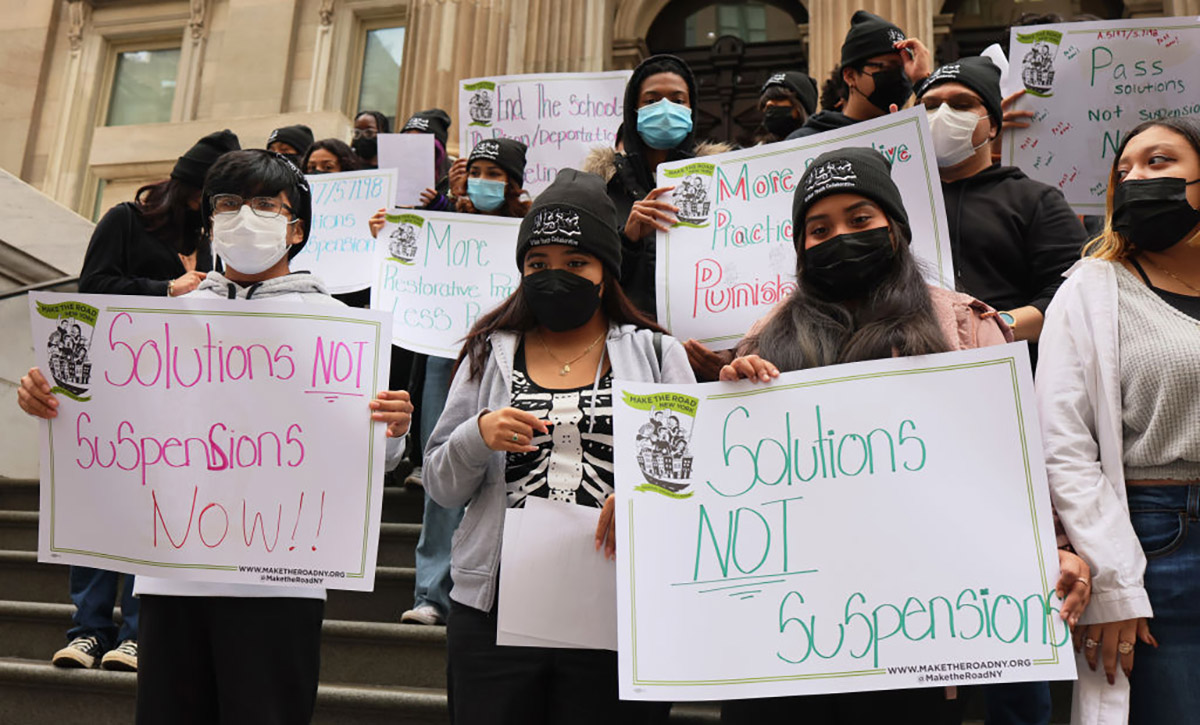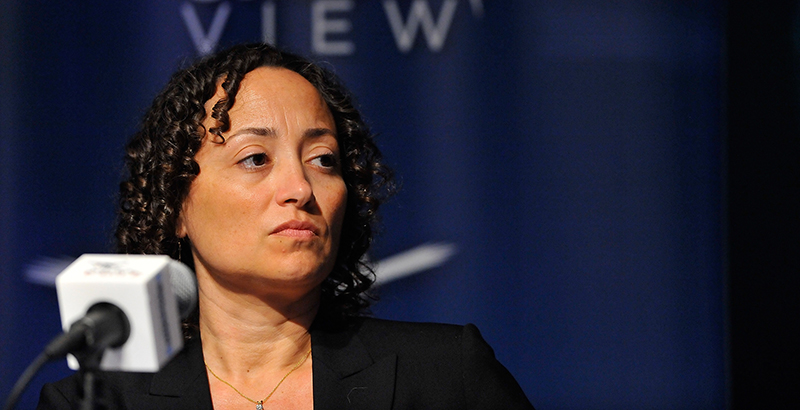In a Year of ‘Abysmal’ Student Behavior, Ed Dept. Seeks Discipline Overhaul
For the third time in 8 years, the department is trying to retool its guidance, but the pandemic offers a troubling new context

Get stories like this delivered straight to your inbox. Sign up for The 74 Newsletter
This summer marks the third time in eight years that the U.S. Department of Education is overhauling its policy on how school districts should handle student discipline.
And while the controversy surrounding the issue hasn’t changed, the pandemic offers up a troubling new context: Districts are reporting spikes in student misconduct, violent attacks on school employees and blatant disregard for school rules.
“There is certainly a much higher level of dysregulation in our kids,” said Rico Munn, superintendent of the Aurora Public Schools in Colorado. He added that educators usually expect students to fall into a routine and follow rules by September. “We weren’t hitting that until spring break.”
The education department is expected to update its policy in two parts. One will focus on students with disabilities, who are significantly more likely to be suspended and expelled than non-disabled students. The other will address racial gaps in discipline — a reality that persists in many districts despite widespread efforts over the past decade to keep students from being removed from school and often referred to police.
Advocates for students’ educational rights are eager for the department to make a strong statement against discipline that keeps students out of the classroom.
“Discipline is inherently an authoritative tool used to punish students for being what an adult has decided is disobedient,” said Denise Stile Marshall, president of the Council of Parent Attorneys and Advocates, which focuses on the rights of students with disabilities. “There is a lot of research on this, but simply put, punitive school discipline does not improve student behavior or academic achievement.”

If that sounds familiar, it’s not accidental. The person leading the department’s effort is Catherine Lhamon, assistant secretary at the Office for Civil Rights, the same position she held under President Barack Obama. Seth Galanter, who worked with Lhamon during the Obama years, has also returned to the civil rights office after four years at the National Center for Youth Law.
In 2014, the Obama administration issued a document saying that schools where Black and Hispanic students were disproportionately removed for disciplinary reasons could be in violation of federal civil rights laws — even if those students misbehaved at higher rates.
Former Education Secretary Betsy DeVos rescinded that guidance in 2018, siding with those who called the move “coercive” and said it misinterpreted civil rights laws meant to prevent discrimination.
The Biden administration comes to the issue not only more sympathetic to the idea of restorative justice, but in the midst of a pandemic that has seen an increase in student misbehavior. One North Carolina official said student behavior was so “abysmal” that educators were afraid for their safety.
‘A year of disrupted schooling’
That’s one reason why Michael Petrilli, president of the conservative Thomas B. Fordham Institute, said in January that the department should hold off on new guidance, arguing that districts shouldn’t have to fear a federal investigation for removing disruptive students from the classroom.
The pandemic, he noted, was worse for low-income Black and Hispanic students, who were more likely to attend schools that had been closed longer.
“The very same students that have more catching up to do after a year of disrupted schooling are also facing the prospect of a more challenging learning environment if schools are hesitant to remove problem students,” he wrote.
Others say the pandemic shouldn’t interrupt the administration’s efforts to revisit the issue of bias in school discipline.
“It is always a good time to say that racial discrimination is wrong [and] that children with disabilities have the right to be alongside their non-disabled peers,” said Liz King, the senior program director for education at the Leadership Conference on Civil and Human Rights.
She thinks the guidance should reflect recent research showing police in schools don’t reduce gun violence but do increase suspensions, expulsion and arrests of students — especially for Black students. She wants the department to take a stand against seclusion and restraint of students and “lean in” to the rights of Black and Hispanic girls and LGBTQ students.
Data shows Black girls are five times more likely than white girls to be suspended from school at least once and four times more likely to be arrested at school. A 2016 analysis from advocacy group GLSEN found that LGBTQ students are suspended at higher rates than non-LGBTQ students.
‘Absolutely a dance’
The Obama-era guidance embraced so-called restorative justice practices that aim to give students a chance to build stronger relationships, work out their grievances and make amends for their actions in lieu of suspension. Twenty-one states and the District of Columbia have passed laws supporting the model, according to the Center on Poverty and Inequality at Georgetown Law School.
Earlier research on such programs was mixed, but a more recent analysis from California showed restorative practices can shrink Black-white discipline disparities and are associated with higher grade point averages in high school.
But “good discipline is very expensive” and hard to implement with the “regular teacher allocation in the school,” said Elliott Duchon, former superintendent of the Jurupa Unified School District, near Los Angeles.
His district launched a multi-year effort to reduce suspensions and expulsions after federal officials found that Hispanic students were more likely to be suspended than white students.
Los Angeles Unified’s restorative justice program costs $13 million a year, according to the district, and funding for the Oakland district’s program — considered a national model — was almost cut until the city and private funders stepped in to pick up the cost.
Critics of alternative discipline practices argue the Obama-era guidance created tension between teachers who make discipline referrals and administrators who send students back to class without any consequences.
“It’s absolutely a dance,” said Jacqueline Shirey, at-risk coordinator for the Beaumont Independent School District in Texas. “If we are going to say that students can’t leave, what are we doing to help the teachers?”
With that in mind, Shirey began training teachers last fall to set up “de-escalation” spaces in their classrooms — a desk with a box that includes stress balls, 500-piece puzzles and writing materials.
“I saw a way for students to learn how to manage their own emotions before it became disruptive, and I didn’t want students to leave my classroom to do that,” she said, but added that ground rules are necessary. “If you don’t implement it with a purpose, then it really does become supplies in a corner that students can play with.”
When students returned last fall, some administrators decided it was important to take a business-as-usual approach to discipline.
In Nashville, Hunters Lane High School Principal Susan Kessler said her teachers “enforce dress code this year and every year” and that it helps in “maintaining school culture, enforcing building security and reducing distractions in the classroom.”
Other school leaders factored in the impact of school closures on students’ behavior.
Aaron Eyler, principal at Matawan Regional High School in Aberdeen, New Jersey, brought his staff together in September for a frank conversation about what to expect when students returned.
He told them not to worry about trying to “win the battle” against students wearing hoodies and hats. And he wasn’t surprised to see more of what he referred to as insubordination, like students wearing Airpods and being late to class. The point, he said, was to keep students from missing even more instruction.
“With … what happened last year and the lack of consistent structure,” he said, “there was no way we weren’t going to have greater instances of discipline than what we’re accustomed to in school.”
Ronn Nozoe, executive director of the National Association of Secondary School Principals, said any guidance from the department is likely to “ruffle feathers,” but he added, “You never want to tie the hands of folks who are actually doing the work.”
Get stories like these delivered straight to your inbox. Sign up for The 74 Newsletter

;)
